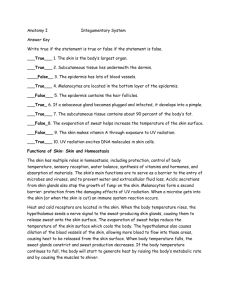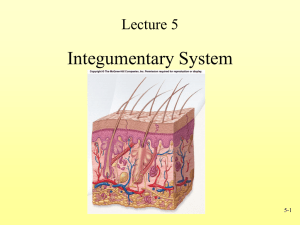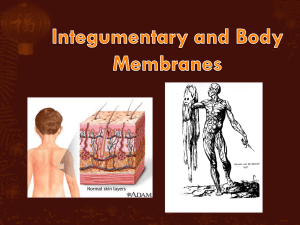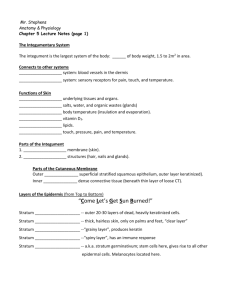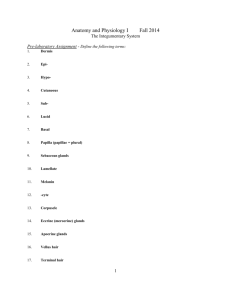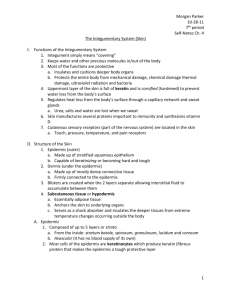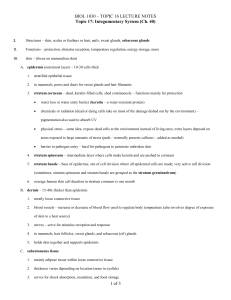Integumentary+System
advertisement
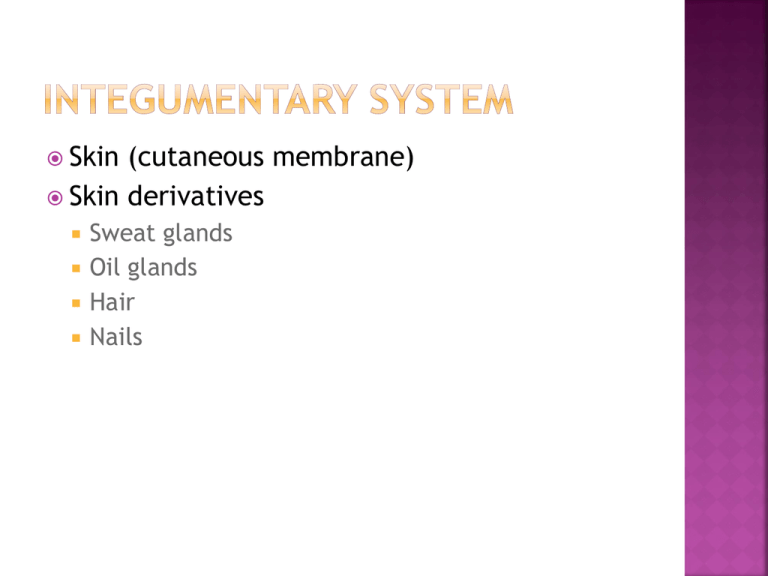
Skin (cutaneous membrane) Skin derivatives Sweat glands Oil glands Hair Nails Protection from mechanical damage Protection from chemical damage Protection from thermal damage Protection from bacterial invasion Table 4.1 (1 of 2) Table 4.1 (2 of 2) Epidermis—outer layer Stratified squamous epithelium Most cells are keratinocytes- produce keratin Often keratinized (hardened by keratin- tough and leather-like) Avascular- no blood vessels Dermis Dense connective tissue- has abundant elastic and collagenic fibers Major skin area where derivatives (nails and hair) reside Figure 4.3 Subcutaneous tissue (hypodermis) is deep to dermis Not part of the skin Anchors skin to underlying organs Composed mostly of adipose tissue Stratum basale (stratum germinativum) Deepest layer of epidermis Lies next to dermis Cells undergoing mitosis Daughter cells are pushed upward to become the more superficial layers Stratum spinosum Stratum granulosum Layer containing sacs filled with fatty material or keratin subunits Stratum Formed from dead cells of the deeper strata Occurs only in thick, hairless skin of the palms of hands and soles of feet Stratum lucidum corneum Outermost (superficial) layer of epidermis Shingle-like dead cells are filled with keratin (protective protein prevents water loss from skin) Accounts for most of the epidermis Summary of layers from deepest to most superficial Stratum basale Stratum spinosum Stratum granulosum Stratum lucidum (thick, hairless skin only) Stratum corneum Pigment (melanin) produced by melanocytes Melanocytes are mostly in the stratum basale Color is yellow to brown to black Amount of melanin produced depends upon genetics and exposure to sunlight Two layers 1. Papillary layer (upper (superficial) dermal region) Projections called dermal papillae Some contain capillary loops Other house pain receptors and touch receptors 2. Reticular layer (deepest skin layer) Blood vessels Sweat and oil glands Deep pressure receptors Overall Collagen and elastic fibers located throughout the dermis dermis structure Collagen fibers give skin its toughness Elastic fibers give skin elasticity Blood vessels play a role in body temperature regulation Figure 4.4 Melanin Yellow, brown, or black pigments Carotene Orange-yellow pigment from some vegetables Hemoglobin Red coloring from blood cells in dermal capillaries Oxygen content determines the extent of red coloring Cutaneous glands are all exocrine glands Sebaceous glands Sweat glands Hair Hair Nails follicles Sebaceous Produce oil glands Lubricant for skin Prevents brittle hair Kills bacteria Most have ducts that empty into hair follicles; others open directly onto skin surface Glands are activated at puberty Acne is an infection of sebaceous glands Figure 4.6a Sweat glands Produce sweat Widely distributed in skin Two types Eccrine More numerous, Secretions containing water, salts, and vitamin C Open via duct to pore on skin surface Activated by a rise in temperature Activity controlled by nervous system Apocrine Found in axiallary and genital areas Ducts empty into hair follicles Secretions contain fatty acids and protein in addition to water and salts Figure 4.6b Composition Mostly water Salts and vitamin C Some metabolic waste Fatty acids and proteins (apocrine only) Function Helps dissipate excess heat Excretes waste products Acidic nature inhibits bacteria growth Odor is from associated bacteria Hair Produced by hair follicle Consists of hard keratinized epithelial cells Melanocytes provide pigment for hair color Figure 4.7c Hair anatomy Central medulla Cortex surrounds medulla Cuticle on outside of cortex Most heavily keratinized Figure 4.7b Associated Hair follicle Dermal and epidermal sheath surround hair root Arrector pili muscle hair structures Smooth muscle Pulls hairs upright when cold or frightened (environmental stimuli) Sebaceous gland Sweat gland Hair follicles and sebaceous glands are found everywhere in body except soles of feet and palms of hands Figure 4.7a Figure 4.8 Nails Scale-like modifications of the epidermis Stratum basale extends beneath the nail bed Heavily keratinized Responsible for growth Lack of pigment makes them colorless Nail structures Free edge Body is the visible attached portion Root of nail embedded in skin Cuticle is the proximal nail fold that projects onto the nail body Figure 4.9



